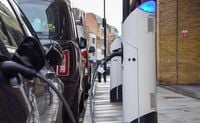Electric vehicle (EV) sales have surged to unprecedented heights in both the United Kingdom and the United States this autumn, as new government incentives, expanded model options, and shifting consumer attitudes have combined to propel the market into record territory. According to the Society of Motor Manufacturers and Traders (SMMT), the UK saw 72,779 pure battery electric vehicles registered in September 2025 alone—a staggering 29.1% increase from the same month last year. This marks the best month on record for battery electric vehicle (BEV) volumes, with BEVs now accounting for 23.3% of the UK’s new car market.
Plug-in hybrid vehicles also recorded even faster growth, and for the first time, electrified vehicles—meaning fully electric and hybrid models—made up more than half of all new car registrations in the UK in September. The SMMT attributed this surge to a confluence of factors: aggressive manufacturer discounts, a rapidly growing selection of more than 140 EV models (from city runarounds to family SUVs), and, crucially, the introduction of the government’s Electric Car Grant (ECG) scheme over the summer.
The ECG offers discounts of up to £3,750 on eligible new EVs priced at or under £37,000, with the largest reductions reserved for the most environmentally friendly models. As of early October, more than 20,000 buyers had taken advantage of the grant, which currently applies to about a quarter of available BEVs and covers 36 models, with more expected to join soon. The UK government has invested £650 million in the scheme, which is designed to help break down one of the most persistent barriers for would-be EV buyers: high upfront costs. SMMT chief executive Mike Hawes told the BBC, “Electrified vehicles are powering market growth after a sluggish summer, and with record ZEV uptake, massive industry investment is paying off, despite demand still trailing ambition.”
Transport Secretary Heidi Alexander echoed this sentiment, stating, “Our discounts have sparked a surge in electric car sales, making them cheaper and within reach of more households than ever before. By cutting costs for families, we’re supporting industry, backing British jobs, and powering up growth.”
The impact of the grant has been immediate and dramatic. Ian Plummer, Autotrader’s chief commercial officer, noted, “Since July, enquiries for new electric vehicles on Autotrader are up by almost 50%. For models eligible for the grant, interest has more than doubled.” Industry data also shows that the upfront cost of new electric vehicles has dropped by 14% compared to last year, narrowing the gap with petrol and diesel equivalents to an average of £8,229. The knock-on effect has even reached the used car market, with prices for second-hand EVs also falling.
Ford was the first manufacturer to qualify for the full grant, and its Puma Gen-E model saw a significant spike in sales as a result. The Kia Sportage, Ford Puma, and Nissan Qashqai were the best-selling cars in September, but two Chinese models—the Jaecoo 7 and BYD Seal U—also cracked the UK’s top ten, highlighting the increasingly global nature of the EV market.
Government policy is also playing a pivotal role. Under the UK’s zero-emission vehicle (ZEV) mandate, at least 28% of new cars sold by each manufacturer this year must be zero emission, a requirement that has helped drive BEV market share above 22% for the year so far. The ECG is part of a broader strategy to phase out sales of new petrol and diesel cars by 2030, a goal that has been reinforced by both government and industry leaders. A recent survey commissioned by Renault found that 35% of UK drivers are more inclined to switch to electric vehicles as a direct result of the grant.
Not everyone is convinced the grant is the magic bullet for mass adoption. David Farrar, policy manager for New AutoMotive, commented, “The Electric Car Grant has sent a strong signal of government commitment to EVs, supporting consumer confidence, the expanding used market and green jobs in markets closer to home. But it isn’t yet clear that it’s prompting consumers to consider buying cars that they wouldn’t have gone ahead and bought anyway.” The Department for Transport, however, dismissed this skepticism, calling such analysis “incorrect.”
Across the Atlantic, the U.S. has experienced its own EV sales boom, driven by a rush to take advantage of federal tax credits of up to $7,500 before they expired at the end of September. According to CNBC, U.S. sales of all-electric vehicles (excluding hybrids) topped 1 million units through September 2025, with a record 438,000 EVs sold in the third quarter alone. This pushed EVs to a 10.5% market share for the period, up sharply from 7.4% in the previous quarter.
Tesla remains the dominant player in the U.S. market, holding an estimated 43.1% share through September, though that figure is down from 49% at the end of 2024 as new competitors enter the fray. General Motors has made significant gains, increasing its EV market share from 8.7% at the start of the year to 13.8% by the third quarter, selling 144,668 EVs—representing 6.8% of its total U.S. sales. Ford, Volkswagen, Honda, and BMW also reported notable market shares.
The New York Times reported that the looming expiration of the federal tax credit prompted a 22% year-over-year jump in U.S. EV sales during the third quarter, reaching approximately 410,000 vehicles. Ford saw its EV sales rise by 30%, General Motors more than doubled its EV sales, and Hyundai’s EV sales also doubled compared to the previous year. Tesla delivered 497,000 vehicles worldwide in the third quarter, a 7% increase from a year earlier.
However, the end of the tax credits has cast a shadow over the future pace of EV adoption in the U.S. Ford CEO Jim Farley told CNBC he “wouldn’t be surprised” if industry market share for EVs dropped from around 10% to as low as 5% following the expiration of the incentives. Industry analysts and executives widely expect a sales slump in the coming months, as the incentives that fueled recent growth have now disappeared.
Globally, China continues to lead the way in EV adoption, with the International Energy Agency reporting 6.4 million all-electric vehicles sold there last year, compared to 2.2 million in Europe. While the UK and U.S. have made remarkable strides in 2025, both markets still have a long road ahead to match the scale and consistency of China’s EV transition.
As policymakers and automakers navigate the next phase—balancing incentives, infrastructure, and consumer confidence—the electric vehicle revolution shows no signs of stopping, even if the road ahead may have a few bumps.






